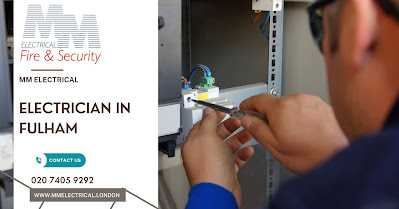Home Rewiring: Tips from electrician in London
Home Rewiring: Tips from electrician in London
There is no denying the fact that at some point in time, you need to undertake a home rewiring project. It is always a good idea to hire a licensed electrician in London for the same. Electricity is potentially hazardous. Therefore, it is quite important to understand the basics of how electricity works so that you and your family remain safe.
In the following sections of the blog post, we will explore some practical tips shared by professional electrician in London on how to rewire a house safely DIY.
Expert Pointers from Top electrician in London
Take Precautions
Before starting the task of rewiring, it is always important to take necessary precautions to ensure safety.
- Choose rubber-insulated tools. Handles of tools that have rubber insulation absorb electric shocks, and the shock will not flow through your body.
- It would be best if you had a good current tester. For it, you will have to spend a decent amount of money.
- Wear the right clothing and eye protection before undertaking this heavy task.
- You must remain very cautious while climbing up and down the stairs or working in rafters.
- Make sure to turn off the electric circuit before starting the work. You can either disconnect the power supply from the main switch or only at the loop that you are working on. After stitching off the supply, check using a tester if the electrical line is dead and only then should you start your work.
Make a concrete plan before working.
Before you start an electrical rewiring project, make sure you make a concrete plan. You can do so by easily evaluating your existing lighting and outlet. While running this evaluation, you can make necessary changes or updates in the wiring. See if the electrical box is too old and needs replacement. Electric wiring provides a great opportunity to add new wires to the circuit. However, it is important to ensure that your additions should be within the country code. We always recommend our readers hire professional emergency electrician in London to upgrade the existing wiring.
Removing Old Wires
Professional Electrician Fulham have something important to share on this. It is a good idea to start the rewiring project after a certified electrician looks around your house and evaluates the existing wiring. Just because the wiring is old, it does not mean that it has to be replaced completely. Rather, a professional evaluation will help you to identify the problematic areas. This is how you can save your time, money and effort.
Installing New Wires
Unless you have started a major home renovation, there is no need to replace the wires completely. Try routing the wires through the attic. Drill holes carefully because you may accidentally damage the plumbing lines. If you are adding a new line that splits into new outlets, please be sure that you add a junction box in between to ensure electrical safety.
During the process, you must lay new wires and branch them to various electrical outlets. When you do this, you will need a pair of helping hands as it will make the task much easier. You can staple the wires to nearby supporting beams. Before capping the wires, you can use tape to wind them together. Be cautious while matching up the wires in the process.
Know the breaker box.
Qualified and registered electrician in London suggest that you should have enough wire if you are working on the breaker box. Make sure that you are connecting the right circuits to the right breaker box. Remember to label the breaker boxes because if you forget to label them, you might jumble them later. Test the system only after wiring from an electrical outlet to the relevant breaker box. Lastly, request a visit from the inspector before you cover up the access points.
Keep a little technicalities in mind.
Residential home wiring requires 240 volts instead of 120 volts. This is because residential areas have large appliances like heating or cooling systems. 240 volts circuits were initially known as 220 volts in 1960. In the same way, 110-volt circuits are now 120 volts.
A 240-volt circuit powers the main electric panel. There are 3 wires - 2 wires that carry 120 volts each and a neutral wire. Each wire carrying 120 volts is 180 degrees out of phase with the other. The neutral wire stays the same for both powered lines.
- Any multi-meter reading across a powered wire and the neutral will show 120 volts.
- 240 volts are read by the multi-meter when it's measured across the powered lines.
Current is measured in amps or amperes. By dividing Wattage (or Watts) by Voltage (or Volts), you can figure out how much current is flowing.
Getting your house rewired yourself will save you a lot of money. However, it would be best to take all the abovementioned precautions to stay safe.
We still recommend our readers to get the rewiring project done by trained electrician in London. Safety is paramount. Take the help of a reliable electrician even if you want to carry out the project yourself.
Read Also:
ELECTRICIAN FULHAM: POWERING UP FULHAM
.jpg)



.jpg)
Comments
Post a Comment